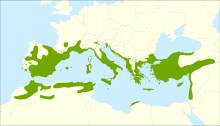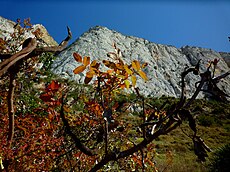| Pistacia terebinthus | |
|---|---|

| |
| Scientific classification | |
| Kingdom: | Plantae |
| Clade: | Tracheophytes |
| Clade: | Angiosperms |
| Clade: | Eudicots |
| Clade: | Rosids |
| Order: | Sapindales |
| Family: | Anacardiaceae |
| Genus: | Pistacia |
| Species: | P. terebinthus |
| Binomial name | |
| Pistacia terebinthus L. | |

| |
| Distribution | |
| Synonyms | |
| |


Pistacia terebinthus also called the terebinth /ˈtɛrəˌbɪnθ/ and the turpentine tree, is a deciduous shrub species of the genus Pistacia, native to the Mediterranean region from the western regions of Morocco and Portugal to Greece and western and southeastern Turkey. At one time terebinths growing on the eastern shores of the Mediterranean Sea (in Syria, Lebanon and Israel) were regarded as a separate species, Pistacia palaestina, but these are now considered to be a synonym of P. terebinthus.
Description
The terebinth is a deciduous flowering plant belonging to the cashew family, Anacardiaceae; a small tree or large shrub, it grows to 10 m (33 ft) tall. The leaves are compound, 10–20 cm (3.9–7.9 in) long, odd pinnate with five to eleven opposite glossy oval leaflets, the leaflets 2–6 cm (0.79–2.36 in) long and 1–3 cm (0.39–1.18 in) broad. The flowers are reddish-purple, appearing with the new leaves in early spring. The fruit consists of small, globular drupes 5–7 mm (0.20–0.28 in) long, red to black when ripe. All parts of the plant have a strong resinous smell.
The terebinth is a dioecious tree, i.e. it exists as male and female specimens. For a viable population both sexes must be present. The oblong leaf is bright green, leathery, with 10 cm (3.9 in) long or more with three to nine leaflets. Leaves alternate, leathery and compound paripinnate (no terminal leaflet) with three or six deep green leaflets. They are generally larger and rounder than the leaves of the mastic, reminiscent of the leaves of carob tree. The flowers range from purple to green, the fruit is the size of a pea and turns from red to brown, depending on the degree of maturation. The whole plant emits a strong smell: bitter, resinous, or medicinal. In the vegetative period they develop "galls" shaped like a goat's horn (from which the plant gets the name "cornicabra", the common name in Spanish), that occur on the leaves and leaflets which have been bitten by insects.
The species propagates by seeds and shoots. Although marred by the presence of galls, it is a very strong and resistant tree which survives in degraded areas where other species have been eliminated. Pistacia terebinthus is related to Pistacia lentiscus, with which it hybridizes frequently in contact zones. Pistacia terebinthus is more abundant in the mountains and inland and the mastic is usually found more frequently in areas where the Mediterranean influence of the sea moderates the climate. The mastic tree does not reach the size of the Pistacia terebinthus, but the hybrids are very difficult to distinguish. The mastic has winged stalks to its leaflets, i.e., the stalks are flattened and with side fins, whereas these stems in Pistacia terebinthus are simple. On the west coast of the Mediterranean, Canary Islands and Middle East, P. terebinthus can be confused with P. atlantica.
Habitat


The terebinth prefers relatively moist areas, up to 600 m (2,000 ft) in elevation. It tolerates more intense frost and summer drought than mastic can. The plant is common in the garrigue and maquis. It appears in deciduous oak wood. It has a gray trunk that is very aromatic, and may have multiple trunks or stems when grown as a shrub. Usually reaching 5 m (16 ft) in height, although in rare cases can reach 10 m (33 ft). P. terebinthus is one of the European species of Anacardiaceae, a family of about 600 mostly tropical species. It can be found to 1,500 m (4,900 ft) above sea level. P. terebinthus is more moisture demanding than the mastic and more resistant to cold. It requires a sunny exposure and average soils, tolerating lime and some salt, often grows near the sea, deep ravines and near salt-lakes and streams.
History
Historian of Mycenae John Chadwick believes that the terebinth is the plant called ki-ta-no in some of the Linear B tablets. He cites the work of a Spanish scholar, J. L. Melena, who had found "an ancient lexicon which showed that kritanos was another name for the turpentine tree, and that the Mycenaean spelling could represent a variant form of this word."
The Latin name is underlain by the Ancient Greek name τερέβινθος which, in turn, is underlain by a pre-Greek Pelasgian word, marked by the characteristic consonant complex νθ.
Terebinth from Oricum is referred to in Virgil's Aeneid, Book 10, line 136, where Ascanius in battle is compared to "ivory skilfully inlaid in Orician terebinth" ("inclusum Oricia terebintho ebur").
Terebinth is referred to by Robin Lane Fox in Alexander the Great: "When a Persian king took the throne, he attended Pasargadae, site of King Cyrus's tomb, and dressed in a rough leather uniform to eat a ritual meal of figs, sour milk and leaves of terebinth."
The terebinth is mentioned in the Hebrew Scriptures (or Old Testament), where the Hebrew word elah (plural elot) is used, although the word is sometimes translated as 'oak'. It is clear that the translators are uncertain which translation is correct, , yet the two are very different trees to any but the most superficial observation. (The Hebrew word alon means 'oak', and the words may be related.)
The word terebinth is found in three successive chapters of Genesis (12:6, 13:18, 14:13, 18:1) in reference to the places where Abram (later Abraham) camped called "Terebinths of Mam're the Amorite". Here, the traditional rendering in English is "oaks of Mamre."
It is also found in Genesis chapter 35, where Jacob commands his family to remove idols that were taken as booty from the battle in Shechem before travelling to Bethel.
Terebinths are also found in Isaiah in possible reference to idolatry associated with the trees, although in the Septuagint and Vulgate the word is translated 'idols', as the plural of el.)
For you will be ashamed of the terebinths that you have taken pleasure in.
— Isaiah 1:29
The best known clear reference to a terebinth (elah) in the Hebrew Scriptures is that of the Valley of Elah or 'Valley of the Terebinth' (עמק האלה), where David fought Goliath (1 Samuel 17:2, 17:19).
Later in 2 Samuel 18:9 David's rebellious son Absalom is caught in the terebinth tree and is killed by Joab and his men, who were part of David's army (2 Samuel 18:14–15).
At least a few references occur in Judges: chapter 4 (in reference to Heber, the Kenite, of the children of Hobab), chapter 6 (in reference to an angel of the Lord who came to visit Gideon—most versions use 'oak'), and Ch 9 (in reference to the crowning of Abimelech, by the terebinth of the pillar that was in Shechem—again most versions use 'oak'). This reference of Abimelech's crowning by an oak is actually referring to the Palestine oak, closely related to the Kermes oak (Quercus coccifera). The Hebrew distinguishes the Palestine oak and the terebinth. It is also mentioned in Hosea 4:13 when Hosea is talking about Israel's spiritual adultery by sacrificing to false gods and how to repent and be forgiven in Hosea 14.
Uses
The word "turpentine" was originally used for the exudate of terebinth trees (P. terebinthus and related species such as P. atlantica), now called Chian, Chios, or Cyprian turpentine, and it was later transferred to the crude turpentine (oleoresin) and the oil of turpentine (essential oil) of conifer trees. The word turpentine derives (via Old French and Latin) from the Greek word τερεβινθίνη (terebinthínē), the feminine form (to go with the feminine Greek word for resin) of an adjective τερεβίνθινος (terebínthinos), derived from the Greek noun τερέβινθος (terébinthos), the name for the terebinth tree. However, the main source of the terebinth turpentine is P. atlantica which produces abundant resin instead of P. terebinthus of which the amount of resin is limited.
The fruits are used in Cyprus for baking of a specialty village bread. In Crete, where the plant is called tsikoudia, it is used to flavor the local variety of pomace brandy, also called tsikoudia. In the Northern Sporades the shoots are used as a vegetable (called tsitsíravla). The plant is rich in tannins and resinous substances and was used for its aromatic and medicinal properties in classical Greece. A mild sweet scented gum can be produced from the bark, and galls often found on the plant are used for tanning leather. A triterpene has been extracted from these galls. In Turkey, it is known as menengiç or bıttım. A coffee-like beverage, Kurdish coffee or menengiç kahvesi, is made from the roasted fruit, and a soap is made from the oil. Terebinth resin was used as a wine preservative in the entire ancient Near East, as proven by many findings in areas such as the foot of the Zagros Mountains and Middle Bronze Age Galilee.
Gallery
-
Inflorescence
-
Pistacia adds red to the landscape Mount Meron, Israel
-
 Leaves and stalk
Leaves and stalk
-
 Pistacia terebinthus in Kythera.
Pistacia terebinthus in Kythera.
-
 Pistacia terebinthus at Sounion.
Pistacia terebinthus at Sounion.
See also
References
- "The Plant List: A Working List of All Plant Species". Retrieved 21 November 2014.
- "Palestine Terebinth - Pistacia terebinthus subsp. Palaestina". Archived from the original on 2021-07-01.
- John Chadwick, The Mycenaean World (Cambridge: University Press, 1976), p. 120; Jose Melena, Durius v. 2 "ki-ta-no en las tabillas de Cnoso" (1974), p. 45-55
- Robin Lane Fox, Alexander the Great (Penguin Books, 2004), p. 273
- ""Terebinth Definitions and Meaning - Bible Dictionary"". Retrieved 3 Mars 2022
- Robert Alter, (tr.) Genesis, W. W. Norton & Co. New York, London 1996 p.60
- Skeat, Walter W. (1882). A Concise Etymological Dictionary of the English Language. Oxford, UK: Oxford University Press. p. 579.
- ^ Mills, John S.; White, Raymond (1977). "Natural Resins of Art and Archaeology Their Sources, Chemistry, and Identification". Studies in Conservation. 22 (1): 12–31. doi:10.2307/1505670. ISSN 0039-3630. JSTOR 1505670.
- Barnhart, R. K. (1995). The Barnhart Concise Dictionary of Etymology. New York: Harper Collins. ISBN 0-06-270084-7.
- Beckmann, Sabine (2012). "Resin and Ritual Purification: Terebinth in Eastern Mediterranean Bronze Age Cult". In Stampolidēs, Nikolaos Chr.; Kanta, Athanasia; Giannikourē, Angelikē (eds.). Athanasia: The Earthly, the Celestial and the Underworld in the Mediterranean from the Late Bronze and the Early Iron Age. International Archaeological Conference, Rhodes 2009. Hērakleio: Panistēmio Krētēs. pp. 29–42. ISBN 978-960-7143-40-2.
- Giner-Larza, E. M; Máñez, S; Giner, R. M; et al. (2002). "Anti-inflammatory triterpenes from Pistacia terebinthus galls". Planta Medica. 68 (4): 311–5. doi:10.1055/s-2002-26749. PMID 11988853. S2CID 1565390.
- "Menengiç Kahvesi Nedir? (Turkish)". harbiyiyorum.com. 14 November 2017.
- Ayala, Francisco J. (March 1, 2011). "Elixir of life: In vino veritas". PNAS. 108 (9): 3457–3458. Bibcode:2011PNAS..108.3457A. doi:10.1073/pnas.1019729108. PMC 3048131. PMID 21292988. Retrieved 2 May 2011.
- Ilan Ben Zion (28 August 2014). "Canaanite wine stash found in Galilee unearths ancient flavors". The Times of Israel.
External links
- "Pistacia terebinthus". Plants for a Future.
- Flora Europaea: Pistacia terebinthus
- The Jewish Encyclopedia: Oak and Terebinth
- Kypros.org
| Taxon identifiers | |
|---|---|
| Pistacia terebinthus |
|